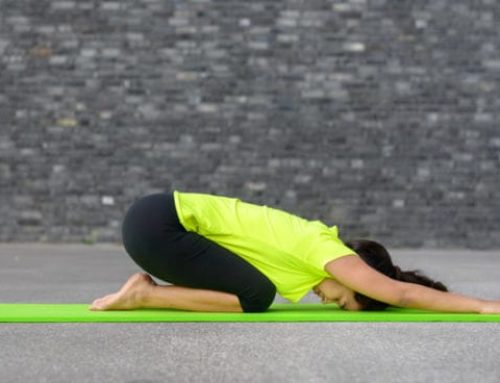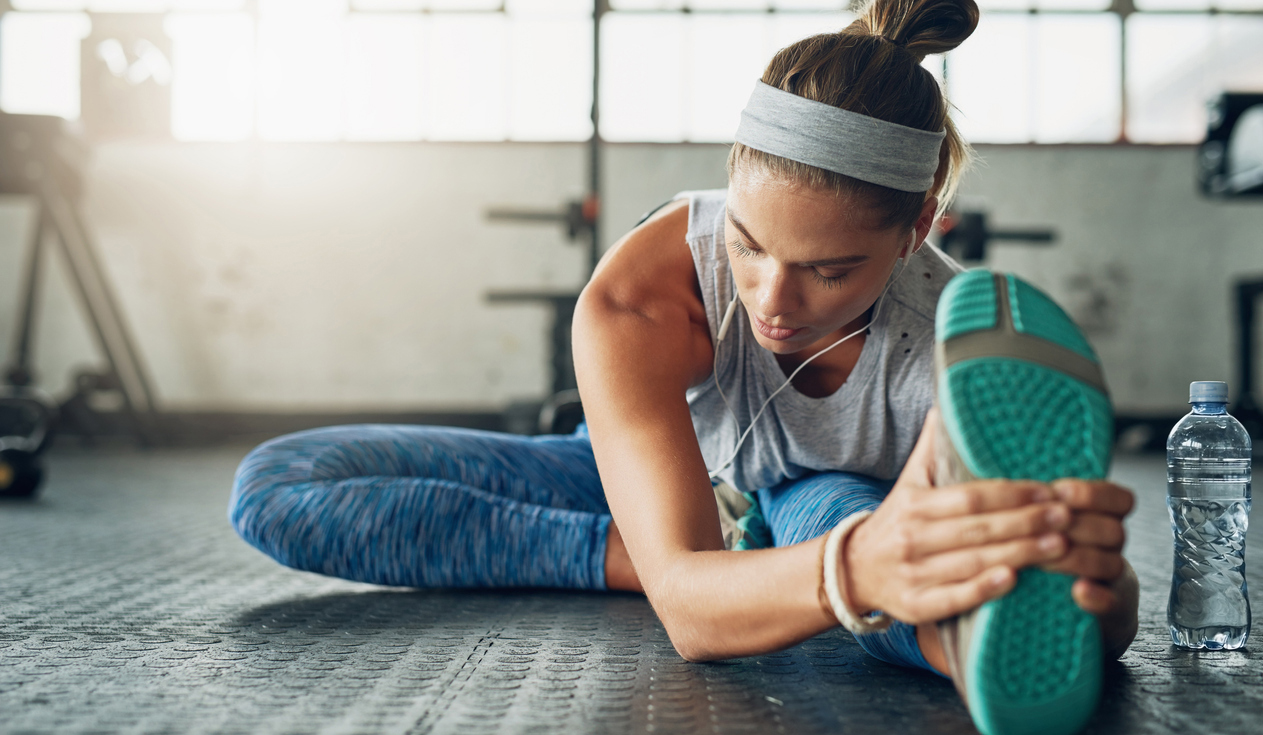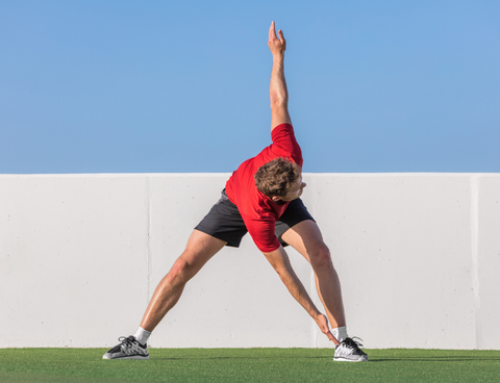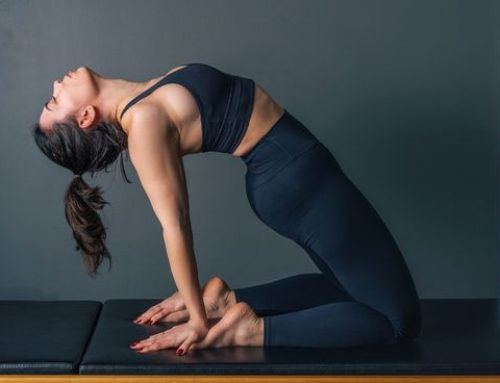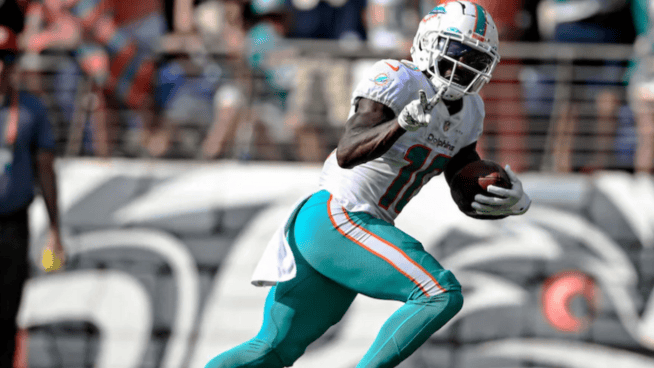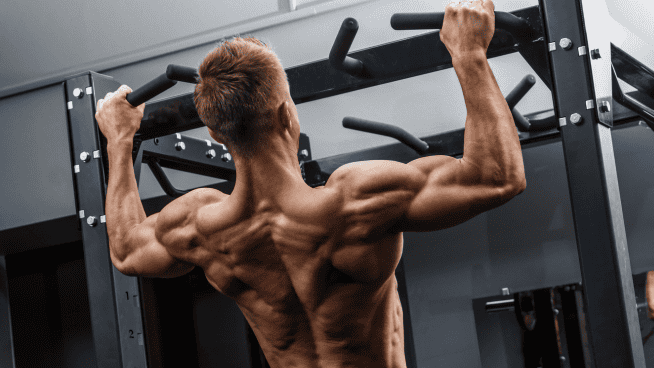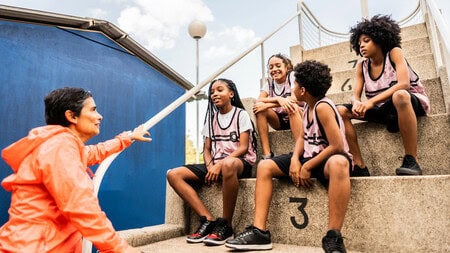The Yoga Warm-Up for Basketball Players
How can yoga help a basketball player before a game?
You’re thinking about the game—the cheers and jeers you’ll hear from the crowd, the tough opponent you’ll have to cover, the contributions (points, rebounds, assists) your teammates are counting on you to make.
You’re so wrapped up in these thoughts that you don’t notice that your hips feel a little off. They’re still tight from yesterday’s workout. The next thing you know, you’re on the court, and—bam!—the shifty player you’re guarding blows by you. You could not move fluidly enough to stay with him.
Yoga can help you avoid this fate in two ways. First, doing the poses—which are really a series of gentle stretches like the ones you perform in a dynamic warm-up—gives you a few minutes to focus solely on yourself, and to screen out all the extraneous noise (literal and mental) surrounding the game. Yoga clears your mind and improves your ability to focus.
RELATED: Warm Up Kevin Love Style
Second, the yoga positions help warm up your muscles, loosen your joints and enable you to feel any trouble spots that might be brewing—such as those tight hips.
“Yoga allows the athlete to check in with himself and see what’s happening in his body,” says Kent Katich, who became the first yoga teacher ever to be hired full-time by an NBA team when the Los Angeles Clippers brought him in to work with their players. “It helps an athlete slow things down for a moment and really feel what’s going on, especially in their hips, glutes and hamstrings.”
From 2004 to 2013, Katich traveled with the Clippers to every game, helping each player get his body ready for the night’s contest. “Each guy would have his time,” Katich says. “[Clippers Center] DeAndre Jordan was first, so he would start at 5:15 p.m. Then it was Caron Butler [a small forward who now plays for Detroit], and the list went on. From just after 5 o’clock until about 6:45 [p.m.], each guy would come and get his 15 or 20 minutes.”
RELATED: Kevin Love’s Yoga Regimen
These sessions took place inside the locker room, where players could relax. “It’s not supposed to be overly hard,” Katich says. “A lot of times there might even be a TV on, so when they get into a stretch they can hang out there for a few minutes if they want. It allows the body to open up.”
The length of time a player should spend stretching a muscle has long been debated in the sports performance world, and not every trainer agrees with holding long stretches before competition. But Katich worked closely with other members of the Clippers’ training staff—and with the players—to develop an approach that nearly everyone on the team—including stars like Blake Griffin, Baron Davis and Grant Hill—bought into. On game days, the approach included those 15-minute one-on-one locker room sessions, a short (about 5 minutes) on-court warm-up, and post-game cool-down work.
“I think everyone instinctually needs a routine,” Katich says. “They need something consistent. It’s critical when you’re trying to perform. If you’re all over the place, it’s difficult to find a stream of focus.”
RELATED: 5 Reasons Why Every Basketball Player Should Do Yoga
The specific moves Katich asked athletes to perform varied from player to player. Each Clipper had his own unique needs. But Katich says that nearly every player performed four poses—Happy Baby, Reclining Pigeon, Downward Facing Dog and Runner’s Lunge. He recommends them to you and your teammates to get your bodies and minds right before your next matchup.
In the Locker Room
Katich started his one-on-one work with players a few hours before game time, when the environment was relaxed. He says, “When we are in the locker room and it’s pre-game, it’s not intense.”
The locker room is a private setting, making it the right place to do poses that put you in positions you wouldn’t want to be photographed in, like a stretch you perform on your back. (You wouldn’t want your opponent to see you on your back, right?) Thus, the locker room the ideal place to do Happy Baby, which relaxes the lower back and hips, and Reclining Pigeon, which loosens up the glutes and piriformis—two important muscles in your butt.
Happy Baby
Lie on your back, raise your legs and spread your knees apart. Reach forward with your arms and hook the thumb and index finger of each hand around your big toes. Pull on your toes and drive your knees toward the floor. Keep the soles of your feet pointing toward the ceiling. Your shinbones should be perpendicular to the floor. Your entire lower back should press against the floor. If you feel it rising up, back off the stretch a bit until it flattens out. Hold and breathe into the sensation you feel in your lower back and hips.
Reclining Pigeon
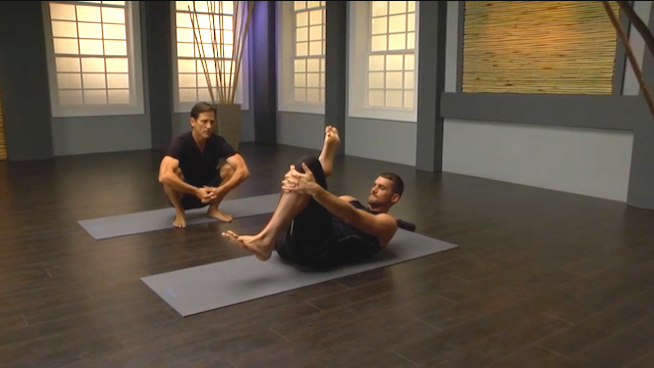
Kevin Love practices Reclining Pigeon Pose while Kent Katich instructs him.
Lie on your back with your knees bent and your feet flat on the ground. Cross your right ankle over your left knee. Flex your right foot, pointing your toes back toward your shin. Interlace your fingers behind your left thigh and pull your left knee toward your chest. You should feel tension in your outer right hip. Keeping your head and shoulders flat, take slow, deep breaths, mentally sending your inhales to the area where you feel the sensation. Hold the pose, then switch sides.
On the Court
Katich says, “When you’re on the court, it’s time to be seen.” With all eyes on his athletes, Katich took care to ask them to perform only moves that convey strength and power. Most were “standing poses,” or moves that kept players on their feet. Katich says, “I don’t like to draw attention to the athletes and what they’re doing if we don’t have to. I don’t want anybody to be self-conscious. The whole point of it is to be confident.”
Two poses that were part of nearly every on-court session are Downward Facing Dog and Runner’s Lunge. Katich calls Downward Facing Dog “the pose of all poses,” because it improves blood flow into the hands while also working the shoulders, calves, lower back and feet. Runner’s Lunge loosens up the all-important hip flexors.
These on-court moves come closer to game time, and they’re meant to be performed a bit more dynamically—i.e., with more movement and shorter hold durations. “On the court, you want to keep the fast-twitch [muscles] going,” Katich says. “You don’t want to over-stretch. You’re moving. You’re active. It’s time to get it going. You’re gonna do these poses, then you’re gonna go and play.”
Downward Facing Dog
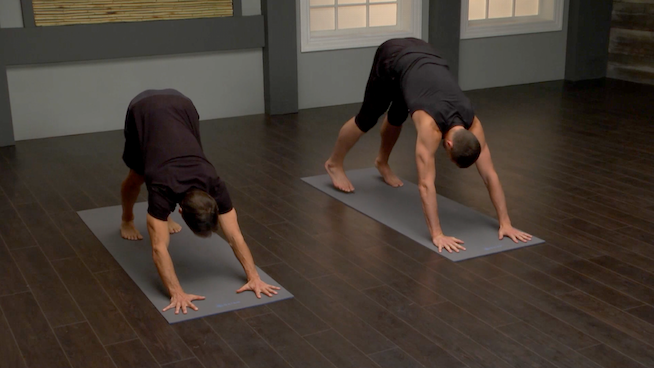
Kent Katich (left) and Kevin Love (right) practice Downward Facing Dog pose.
Begin on all fours in High Plank position. Pull your hips back and up toward the ceiling while keeping your hands planted firmly on the floor. Tuck your head in as you move.
Runner’s Lunge
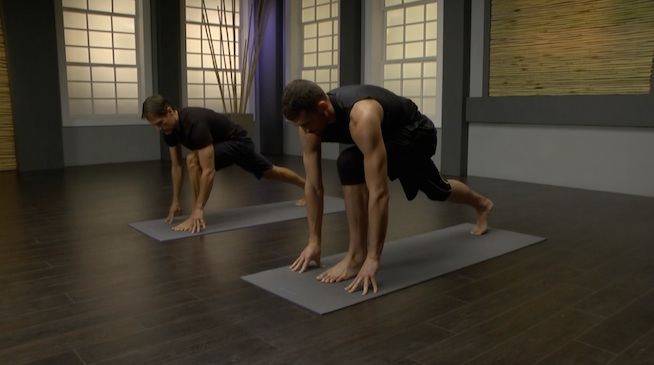
Katich (left) and Kevin Love demonstrate Runner’s Lunge.
From Downward Facing Dog, step your right foot up inside your right hand. Bend your right knee over your ankle so your thigh is parallel to the floor. Align your fingertips with your toes, roll your shoulder blades back and look straight ahead. Hold the pose, then switch to the other foot.
RELATED: Kent Katich and Kevin Love Team up to Release Yoga DVDs
RECOMMENDED FOR YOU
MOST POPULAR
The Yoga Warm-Up for Basketball Players
How can yoga help a basketball player before a game?
You’re thinking about the game—the cheers and jeers you’ll hear from the crowd, the tough opponent you’ll have to cover, the contributions (points, rebounds, assists) your teammates are counting on you to make.
You’re so wrapped up in these thoughts that you don’t notice that your hips feel a little off. They’re still tight from yesterday’s workout. The next thing you know, you’re on the court, and—bam!—the shifty player you’re guarding blows by you. You could not move fluidly enough to stay with him.
Yoga can help you avoid this fate in two ways. First, doing the poses—which are really a series of gentle stretches like the ones you perform in a dynamic warm-up—gives you a few minutes to focus solely on yourself, and to screen out all the extraneous noise (literal and mental) surrounding the game. Yoga clears your mind and improves your ability to focus.
RELATED: Warm Up Kevin Love Style
Second, the yoga positions help warm up your muscles, loosen your joints and enable you to feel any trouble spots that might be brewing—such as those tight hips.
“Yoga allows the athlete to check in with himself and see what’s happening in his body,” says Kent Katich, who became the first yoga teacher ever to be hired full-time by an NBA team when the Los Angeles Clippers brought him in to work with their players. “It helps an athlete slow things down for a moment and really feel what’s going on, especially in their hips, glutes and hamstrings.”
From 2004 to 2013, Katich traveled with the Clippers to every game, helping each player get his body ready for the night’s contest. “Each guy would have his time,” Katich says. “[Clippers Center] DeAndre Jordan was first, so he would start at 5:15 p.m. Then it was Caron Butler [a small forward who now plays for Detroit], and the list went on. From just after 5 o’clock until about 6:45 [p.m.], each guy would come and get his 15 or 20 minutes.”
RELATED: Kevin Love’s Yoga Regimen
These sessions took place inside the locker room, where players could relax. “It’s not supposed to be overly hard,” Katich says. “A lot of times there might even be a TV on, so when they get into a stretch they can hang out there for a few minutes if they want. It allows the body to open up.”
The length of time a player should spend stretching a muscle has long been debated in the sports performance world, and not every trainer agrees with holding long stretches before competition. But Katich worked closely with other members of the Clippers’ training staff—and with the players—to develop an approach that nearly everyone on the team—including stars like Blake Griffin, Baron Davis and Grant Hill—bought into. On game days, the approach included those 15-minute one-on-one locker room sessions, a short (about 5 minutes) on-court warm-up, and post-game cool-down work.
“I think everyone instinctually needs a routine,” Katich says. “They need something consistent. It’s critical when you’re trying to perform. If you’re all over the place, it’s difficult to find a stream of focus.”
RELATED: 5 Reasons Why Every Basketball Player Should Do Yoga
The specific moves Katich asked athletes to perform varied from player to player. Each Clipper had his own unique needs. But Katich says that nearly every player performed four poses—Happy Baby, Reclining Pigeon, Downward Facing Dog and Runner’s Lunge. He recommends them to you and your teammates to get your bodies and minds right before your next matchup.
In the Locker Room
Katich started his one-on-one work with players a few hours before game time, when the environment was relaxed. He says, “When we are in the locker room and it’s pre-game, it’s not intense.”
The locker room is a private setting, making it the right place to do poses that put you in positions you wouldn’t want to be photographed in, like a stretch you perform on your back. (You wouldn’t want your opponent to see you on your back, right?) Thus, the locker room the ideal place to do Happy Baby, which relaxes the lower back and hips, and Reclining Pigeon, which loosens up the glutes and piriformis—two important muscles in your butt.
Happy Baby
Lie on your back, raise your legs and spread your knees apart. Reach forward with your arms and hook the thumb and index finger of each hand around your big toes. Pull on your toes and drive your knees toward the floor. Keep the soles of your feet pointing toward the ceiling. Your shinbones should be perpendicular to the floor. Your entire lower back should press against the floor. If you feel it rising up, back off the stretch a bit until it flattens out. Hold and breathe into the sensation you feel in your lower back and hips.
Reclining Pigeon

Kevin Love practices Reclining Pigeon Pose while Kent Katich instructs him.
Lie on your back with your knees bent and your feet flat on the ground. Cross your right ankle over your left knee. Flex your right foot, pointing your toes back toward your shin. Interlace your fingers behind your left thigh and pull your left knee toward your chest. You should feel tension in your outer right hip. Keeping your head and shoulders flat, take slow, deep breaths, mentally sending your inhales to the area where you feel the sensation. Hold the pose, then switch sides.
On the Court
Katich says, “When you’re on the court, it’s time to be seen.” With all eyes on his athletes, Katich took care to ask them to perform only moves that convey strength and power. Most were “standing poses,” or moves that kept players on their feet. Katich says, “I don’t like to draw attention to the athletes and what they’re doing if we don’t have to. I don’t want anybody to be self-conscious. The whole point of it is to be confident.”
Two poses that were part of nearly every on-court session are Downward Facing Dog and Runner’s Lunge. Katich calls Downward Facing Dog “the pose of all poses,” because it improves blood flow into the hands while also working the shoulders, calves, lower back and feet. Runner’s Lunge loosens up the all-important hip flexors.
These on-court moves come closer to game time, and they’re meant to be performed a bit more dynamically—i.e., with more movement and shorter hold durations. “On the court, you want to keep the fast-twitch [muscles] going,” Katich says. “You don’t want to over-stretch. You’re moving. You’re active. It’s time to get it going. You’re gonna do these poses, then you’re gonna go and play.”
Downward Facing Dog

Kent Katich (left) and Kevin Love (right) practice Downward Facing Dog pose.
Begin on all fours in High Plank position. Pull your hips back and up toward the ceiling while keeping your hands planted firmly on the floor. Tuck your head in as you move.
Runner’s Lunge

Katich (left) and Kevin Love demonstrate Runner’s Lunge.
From Downward Facing Dog, step your right foot up inside your right hand. Bend your right knee over your ankle so your thigh is parallel to the floor. Align your fingertips with your toes, roll your shoulder blades back and look straight ahead. Hold the pose, then switch to the other foot.
RELATED: Kent Katich and Kevin Love Team up to Release Yoga DVDs

